Jarrod Bailey on human-based research
Dr Bailey spends much of his time communicating the scientific basis of opposition to vivisection to the public, to politicians of the UK and European parliaments.
 Following the completion of his PhD in viral genetics in 1998 at Newcastle University, England, Jarrod Bailey spent seven years as a senior postdoctoral research associate examining the causes of premature birth in humans, using human tissue samples. During this time he developed an interest in the relevance and validity of animal experiments to human disease, and now opposes all forms of experimentation in which animals are used as surrogate humans to model human diseases, based on the amount of human harm that has been caused by our reliance upon them.In the last couple of years, he has authored and co-authored reviews outlining the futility of the use of animals to test for substances that can cause birth defects and cancer, and of using chimpanzees and other nonhuman primates in various forms of medical research; he authored Animal Aid’s ‘‘Man or Mouse’‘ report that describes the redundancy of using genetically modified animals to research diseases such as cystic fibrosis, Alzheimer’s and Parkinson’s, among others; and was a chief author of a petition submitted in late 2007 by a coalition of organisations to the Food and Drug Administration, requesting that it requires scientists to use non-animal methods in research and testing in place of animal methods. He has just completed a paper evaluating the role of chimpanzees in the development of AIDS vaccines, and is currently working on scientific projects examining the role of chimpanzee research in a variety of other areas including cancer and heart disease; following up media reports of promised medical ‘‘breakthroughs’‘ based on animal experiments that failed to materialise; and following up failures and adverse reactions to prescription drugs that have been tested in animals.He also spends much of his time communicating the scientific basis of opposition to vivisection to the public, politicians of the UK and European parliaments and other scientists by means of interviews, public lectures and debates, as an Honorary Research Associate at the University of Newcastle, a Senior Research Scientist for the Physicians Committee for Responsible Medicine in Washington DC, and the Science Director of the New England Anti-Vivisection Society.
Following the completion of his PhD in viral genetics in 1998 at Newcastle University, England, Jarrod Bailey spent seven years as a senior postdoctoral research associate examining the causes of premature birth in humans, using human tissue samples. During this time he developed an interest in the relevance and validity of animal experiments to human disease, and now opposes all forms of experimentation in which animals are used as surrogate humans to model human diseases, based on the amount of human harm that has been caused by our reliance upon them.In the last couple of years, he has authored and co-authored reviews outlining the futility of the use of animals to test for substances that can cause birth defects and cancer, and of using chimpanzees and other nonhuman primates in various forms of medical research; he authored Animal Aid’s ‘‘Man or Mouse’‘ report that describes the redundancy of using genetically modified animals to research diseases such as cystic fibrosis, Alzheimer’s and Parkinson’s, among others; and was a chief author of a petition submitted in late 2007 by a coalition of organisations to the Food and Drug Administration, requesting that it requires scientists to use non-animal methods in research and testing in place of animal methods. He has just completed a paper evaluating the role of chimpanzees in the development of AIDS vaccines, and is currently working on scientific projects examining the role of chimpanzee research in a variety of other areas including cancer and heart disease; following up media reports of promised medical ‘‘breakthroughs’‘ based on animal experiments that failed to materialise; and following up failures and adverse reactions to prescription drugs that have been tested in animals.He also spends much of his time communicating the scientific basis of opposition to vivisection to the public, politicians of the UK and European parliaments and other scientists by means of interviews, public lectures and debates, as an Honorary Research Associate at the University of Newcastle, a Senior Research Scientist for the Physicians Committee for Responsible Medicine in Washington DC, and the Science Director of the New England Anti-Vivisection Society.
Antidote Europe (AE): I understand you have worked on foetus malformations. Can you summarize your principal findings?
Jarrod Bailey (JB): Working towards an understanding of adverse events affecting the development of unborn and young children has been central to my research for much of the past 12 years. After spending seven years of my post-doctoral career using human tissue to investigate why babies are born prematurely, I embarked upon a project to assess the relevance of using animal models to determine the risk of birth defects in unborn children when their mothers are exposed to drugs and chemicals while pregnant – a science known as ‘teratology.’ The most infamous example of a teratogen, i.e. something that causes birth defects in the unborn, is the drug Thalidomide, which caused over 10,000 babies to be born with short or absent limbs in the late 1950s and early 1960s.
This review looked at data collected over almost half a century for almost 1400 substances tested in up to 12 species of animal, and looked to see how often a finding in one species correlated with the effects of a particular chemical in another, and also compared the results in non-human species with the risk of birth defects in humans.
We found that known human teratogens were teratogenic in animals just 56% of the time; that fewer than 1 in 40 substances teratogenic in animals have been conclusively linked to human teratogenesis; and that substances such as water, salt and sugar have been classed as teratogens in animals. In short, it would have been more productive to toss a coin to predict human teratogenic risk than to rely on the results of animal experiments.
Furthermore, we compared alternative ‘in vitro’ methods to test substances in this way, and showed that the best method predicts human teratogenic risk in almost 80% of cases, with further room for improvement. Yet, this method is not being used; we must ask why, and how it can be that such an archaic, poor and dangerous approach as animal teratology can be science’s first port of call in the 21st century.
AE: Do you think we know enough about toxic chemicals from human data? For example, do you think there are chemicals that should be taken out of the market without waiting for further evidence on their toxicity?
JB: Human data is unfortunate, but vital. Most human data is ‘after the event,’ and therefore has involved episodes of harm to hundreds, thousands or more individuals. However, making sure systems are in place to monitor human exposure to potentially hazardous substances is crucial because it enables society to respond quickly and to make sure people are removed from unacceptable risk at the earliest opportunity. As it stands now, animal tests that tell us little or nothing about human risk are the ‘gold standard,’ and they serve no one well. For example: I recently co-authored a study looking at the classification of chemicals with regard to their cancer-causing risk in humans. We found that, in almost 60% of cases where the US Environmental Protection Agency (EPA) had only animal data on which to base a decision, they could not classify that substance for human risk. In other words, supporting human data were essential in most cases for the EPA to make an informed decision! This point was underscored by looking at classifications issued by the EPA, and by its European equivalent the International Agency for Research on Cancer (IARC): their decisions agreed only in the 13% of cases that had a significant amount of supporting human data.
So, this shows us that the animal data does not do its job in protecting human health, and that data from a human context is vital. And as you state, there are undoubtedly many chemicals that should be removed from the market with immediate effect, and where waiting for ‘supporting’ data from animal tests will only result in more harm to many people. The most egregious example of this, historically, is smoking…human data showed beyond doubt its negative effects on the health of the human population decades ago, but was overlooked for years on the basis of animal tests that failed to ‘prove’ that smoking caused cancer. Millions of people died as a direct result.
AE: Which methods do you consider most reliable to assess the toxicity of chemical substances, including drugs?
JB: My answer to the previous question should not suggest that there’s little we can do prospectively to assess human risk from exposure to a chemical before it is encountered by people; it merely shows that we need to keep our focus in a human context, and dispense with tests on other species that tell us little or nothing. We are now at a point in time where the most amazing scientific techniques are available to us, that can show us not only the gross effects of a substance on living cells and tissues, but can also reveal exactly how those effects come about; the mechanisms that are responsible. We can grow hundreds of types of human cells in the laboratory, and analyse the biochemical events in those cells in exquisite detail in terms of how genes are responding, what those cells are doing to cope with a toxic insult and which parts of the cell or tissue are affected and in what way.
So, when we can do these things, we have to ask why we’re persisting with looking largely at gross effects of toxicity in animals that demonstrably have such little relevance to the human situation they’re little more than a waste of time and effort. Not only that, but barriers are erected between these better tests and their implementation by regulatory agencies; strict validation requirements that take years are required that the animal tests have never had to face – and that they couldn’t meet if they had to.
Nevertheless, human-based cell assays, toxicogenomics and microdosing, for example, are slowly but surely forcing their way into the reckoning albeit in addition to, rather than as a replacement for, animal tests. No-one claims that these tests are perfect – far from it – but crucially, they are better, and more promising and able to be improved, than animal tests. But we are moving in the right direction, and it is the job of concerned people such as Antidote, EMP, Equivita, BUAV, PCRM in the US and so on, to continue to ensure that we’re moving as quickly as possible.
AE: Do you feel that collaboration among different associations is useful? Do you regularly collaborate with PCRM? With other associations? In different countries?
JB: Collaboration is essential! The strength of our cause and our argument when we work together is greater than the sum of the parts. We must at all costs stand shoulder to shoulder, and help one another; the fight we’re engaged in involves huge, rich, powerful corporations and we can’t be effective against them individually. Working together is important for how we’re perceived by our opponents, but also because it gives us all access to people with different experiences, areas of expertise, contacts and resources.
For example, I work with Europeans for Medical Progress, the Physicians Committee for Responsible Medicine (PCRM) in the USA, and also a project seeking to end chimpanzee research in the USA (Project R&R: Release and Restitution for chimpanzees in US Laboratories) which is overseen by the New England Anti-Vivisection Society (NEAVS). Not only does this give me, personally, a broader knowledge of different areas of animal research, but it benefits those groups because my other associations provide important contacts for help, knowledge and advice, support, not only within those groups but also outside them, in the form of people I meet at conferences and so on. It is also helpful to be associated with groups in other countries such as Antidote (France), Equivita (Italy), and the Association for the Abolition of Animal Experiments (Switzerland), for example, because of the political associations of those groups in each country.
AE: Can you summarize your career (subjects of research)? Have you, at any time, been in the obligation of performing experiments on animals?
JB: The use of animals has never been central to any of my research; even before I became involved in campaigning against it, I instinctively felt that it had to be futile because of species differences; and the more I learn about it, the more that feeling is vindicated. While active in laboratory research (until two years ago), my work used human tissue samples, donated by volunteers in hospital wards adjacent to the lab. This enabled us to examine uterine tissue from women who were not pregnant (from hysterectomies), women who were pregnant but not in labour (who had elected for Caesarean sections), and also from women pregnant but in labour (from emergency Caesareans). By analysing the activity of genes in these tissues, we were able to highlight differences to implicate certain genes and molecular pathways involved in switching the uterus from an inactive state, to a contractile state during labour and birth…ultimately, with the aim of identifying targets for drugs to halt the progression of premature labour, and prevent premature births.
This always seemed, though technically more challenging than animal research, the only way to elucidate what happens during human labour. Scientists I met at conferences were using rodents, sheep, monkeys and apes to address this question – and I always wondered why, when there’s so much human tissue available that can give us directly relevant data!
AE: Has your engagement against animal experiments been the cause of problems in your career, with your peers?
JB: Not for me, but that is because I moved out of the laboratory to campaign against animal research full time. Consequently, I am not reliant on applying for grants to fund research, to bodies that frown upon ‘dissent’ from anyone who questions the validity of the animal research they fund! It is a problem, however, to get work published that attacks, or even casts doubt upon, the relevance of animal experiments. Many scientists deem animal research to be beyond reproach, and actively block any attempt to publish work of this sort. Many scientists are ambivalent about animal research or simply not bothered either way, but perceive attacks on it as attacks against science as a whole and against scientists themselves – which is ludicrous, and something we must try to change. The irony of this is that questioning and evaluating are the essence of scientific investigation, without which science could not exist! It is plain to see, though, that when peoples’ livelihoods, careers, reputations and finances come into consideration, everything changes, and objectivity is impossible.
Nonetheless, I have been heartened and encouraged by the volume and strength of support from many scientists that I have met. Privately, many thousands of scientists share our concerns about animal research and testing, which can only be a good thing. What we have to work on is enabling these scientists to speak out, without fear of retribution from the upper echelons of universities, societies, academic institutions and publications that fear upsetting its advocates. The time will come when a ‘critical mass’ of support is realised, and this will be of enormous benefit to science, humanity, and animals used in laboratories.




